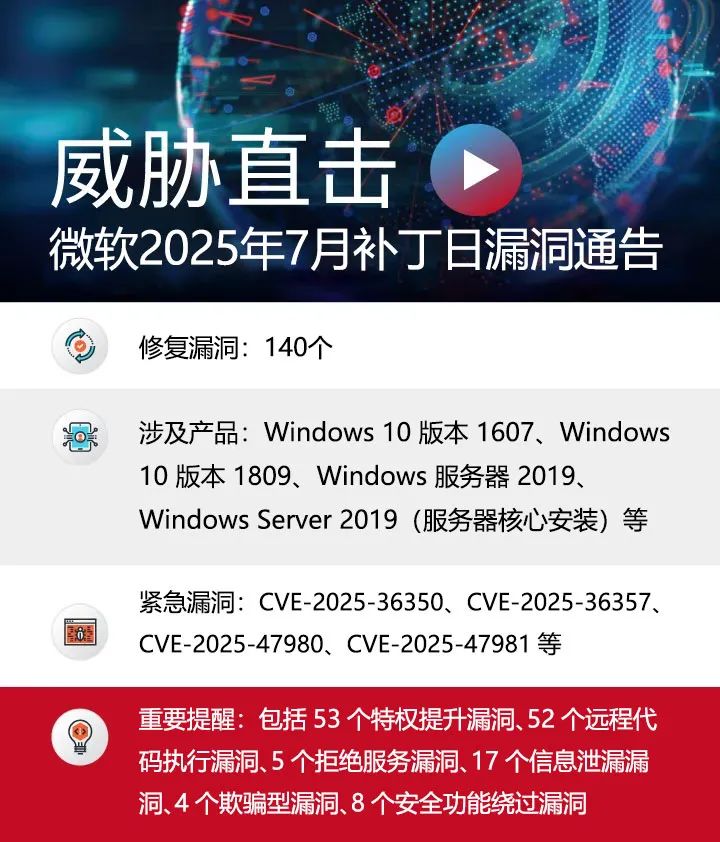涉及140个重要漏洞!微软发布2025年7月补丁日安全通告
原文链接: https://mp.weixin.qq.com/s?__biz=MjM5NjY2MTIzMw==&mid=2650624093&idx=2&sn=9d235e1823de35400fc8f7f6bc25a300
涉及140个重要漏洞!微软发布2025年7月补丁日安全通告
你信任的 亚信安全 2025-07-10 10:39

近日,亚信安全CERT 监测到微软 2025 年 7 月补丁日发布了针对 140 个漏洞的修复补丁(其中10个为额外的第三方CVE记录)。其中,12 个漏洞被评为紧急,127 个漏洞被评为重要,1 个漏洞被评为高危。按漏洞类型划分,本次更新共修复了 。
本月共有12个漏洞被评为紧急,分别为:CVE-2025-36350、CVE-2025-36357、CVE-2025-47980、CVE-2025-47981、CVE-2025-48822、CVE-2025-49695、CVE-2025-49696、CVE-2025-49697、CVE-2025-49702、CVE-2025-49704、CVE-2025-49717、CVE-2025-49735。
经亚信安全CERT专家研判,列出如下部分值得关注的漏洞:
1、AMD 处理器 Store Queue 瞬态调度器旁路漏洞 (CVE-2025-36350)
等级:紧急 │ CVSS 3.1:5.6
披露状态:官方原理及微码已公开,暂无 PoC
在野利用:未发现
技术概述:攻击者可利用 Store Queue / L1 Data Queue 在乱序执行后残留的瞬态状态,通过定时侧信道在同核 SMT 线程间窃取数据;某些虚拟化负载下可能跨 VM。
2、AMD 处理器 L1 Data Queue 瞬态调度器旁路漏洞 (CVE-2025-36357)
等级:紧急 │ CVSS 3.1:5.6
披露状态:同步披露,暂无 PoC
在野利用:未发现
技术概述:攻击者可利用 L1 Data Queue 调度器在乱序执行后留下的瞬态状态,通过计时侧信道在同核 SMT 线程间(并在部分虚拟化场景下跨 VM)窃取数据。该攻击被称为 “Transient Scheduler Attack in L1 Data Queue (TSAL1DQ)”。
3、Windows 图像组件信息泄露漏洞 (CVE-2025-47980)
等级:紧急 │ CVSS 3.1:6.2
披露状态:细节未公开
在野利用:未发现
技术概述:Windows Imaging Component 处理恶意图片时越界读取,导致堆内存信息泄露;暂无证据表明可直接导致 RCE 或提权。
4、SPNEGO 扩展协商 (NEGOEX) 远程代码执行漏洞 (CVE-2025-47981)
等级:紧急 │ CVSS 3.1:9.8
披露状态:细节未公开
在野利用:未发现
技术概述:未认证攻击者可向启用 NEGOEX 的主机发送特制消息,可能以 SYSTEM 权限执行任意代码。
5、Windows Hyper-V 离散设备分配 (DDA) 远程代码执行漏洞 (CVE-2025-48822)
等级:紧急 │ CVSS 3.1:8.6
披露状态:细节未公开
在野利用:未发现
技术概述:在启用离散设备分配(DDA)的 Hyper-V 主机上,拥有宿主管理员或虚拟机管理 API 调用权限的攻击者,可通过导入特制 INF 触发越界读写并执行代码。
漏洞编号
-
CVE-2025-36350 * AMD: CVE-2024-36350 存储队列中的瞬态调度器攻击
-
CVE-2025-36357 * AMD: CVE-2025-36357 L1 数据队列中的瞬态调度器攻击
-
CVE-2025-47980 Windows 图像组件信息泄露漏洞
-
CVE-2025-47981 SPNEGO 扩展协商(NEGOEX)安全机制远程代码执行漏洞
-
CVE-2025-48822 Windows Hyper-V 离散设备分配(DDA)远程代码执行漏洞
-
CVE-2025-49695 Microsoft Office 远程代码执行漏洞
-
CVE-2025-49696 Microsoft Office 远程代码执行漏洞
-
CVE-2025-49697 Microsoft Office 远程代码执行漏洞
-
CVE-2025-49702 Microsoft Office 远程代码执行漏洞
-
CVE-2025-49704 Microsoft SharePoint 远程代码执行漏洞
-
CVE-2025-49717 Microsoft SQL Server 远程代码执行漏洞
-
CVE-2025-49735 Windows KDC 代理服务(KPSSVC)远程代码执行漏洞
-
CVE-2025-6554 * Chromium: CVE-2025-6554 V8 类型混淆漏洞
-
CVE-2025-21195 Azure Service Fabric Runtime 权限提升漏洞
-
CVE-2025-26636 Windows 内核信息泄露漏洞
-
CVE-2025-27613 * MITRE: CVE-2025-27613 Gitk 参数漏洞
-
CVE-2025-27614 * MITRE: CVE-2025-27614 Gitk 任意代码执行漏洞
-
CVE-2025-33054 远程桌面欺骗漏洞
-
CVE-2025-46334 * MITRE: CVE-2025-46334 Git 恶意 Shell 漏洞
-
CVE-2025-46835 * MITRE: CVE-2025-46835 Git 文件覆盖漏洞
-
CVE-2025-47159 Windows 基于虚拟化的安全性(VBS)权限提升漏洞
-
CVE-2025-47178 Microsoft Intune 远程代码执行漏洞
-
CVE-2025-47971 Microsoft 虚拟硬盘权限提升漏洞
-
CVE-2025-47972 Windows 输入法编辑器(IME)权限提升漏洞
-
CVE-2025-47973 Microsoft 虚拟硬盘权限提升漏洞
-
CVE-2025-47975 Windows 简单搜索与发现协议(SSDP)服务权限提升漏洞
-
CVE-2025-47976 Windows 简单搜索与发现协议(SSDP)服务权限提升漏洞
-
CVE-2025-47978 Windows Kerberos 拒绝服务漏洞
-
CVE-2025-47982 Windows Storage VSP 驱动程序权限提升漏洞
-
CVE-2025-47984 Windows GDI 信息泄露漏洞
-
CVE-2025-47985 Windows 事件跟踪权限提升漏洞
-
CVE-2025-47986 通用打印管理服务权限提升漏洞
-
CVE-2025-47987 凭据安全支持提供程序协议(CredSSP)权限提升漏洞
-
CVE-2025-47988 Azure 监控代理远程代码执行漏洞
-
CVE-2025-47991 Windows 输入法编辑器(IME)权限提升漏洞
-
CVE-2025-47993 Microsoft PC 管理器权限提升漏洞
-
CVE-2025-47994 Microsoft Office 权限提升漏洞
-
CVE-2025-47996 Windows MBT 传输驱动程序权限提升漏洞
-
CVE-2025-47998 Windows 路由和远程访问服务(RRAS)远程代码执行漏洞
-
CVE-2025-47999 Windows Hyper-V 拒绝服务漏洞
-
CVE-2025-48000 Windows 连接设备平台服务权限提升漏洞
-
CVE-2025-48001 BitLocker 安全功能绕过漏洞
-
CVE-2025-48002 Windows Hyper-V 信息泄露漏洞
-
CVE-2025-48003 BitLocker 安全功能绕过漏洞
-
CVE-2025-48384 * MITRE: CVE-2025-48384 Git 符号链接漏洞
-
CVE-2025-48385 * MITRE: CVE-2025-48385 Git 协议注入漏洞
-
CVE-2025-48386 * MITRE: CVE-2025-48386 Git 凭据助手漏洞
-
CVE-2025-48799 Windows 更新服务权限提升漏洞
-
CVE-2025-48800 BitLocker 安全功能绕过漏洞
-
CVE-2025-48802 Windows SMB 服务器欺骗漏洞
-
CVE-2025-48803 Windows 基于虚拟化的安全性(VBS)权限提升漏洞
-
CVE-2025-48804 BitLocker 安全功能绕过漏洞
-
CVE-2025-48805 Microsoft MPEG-2 视频扩展远程代码执行漏洞
-
CVE-2025-48806 Microsoft MPEG-2 视频扩展远程代码执行漏洞
-
CVE-2025-48808 Windows 内核信息泄露漏洞
-
CVE-2025-48809 Windows 安全内核模式信息泄露漏洞
-
CVE-2025-48810 Windows 安全内核模式信息泄露漏洞
-
CVE-2025-48811 Windows 基于虚拟化的安全性(VBS)Enclave 权限提升漏洞
-
CVE-2025-48812 Microsoft Excel 信息泄露漏洞
-
CVE-2025-48814 远程桌面授权服务安全功能绕过漏洞
-
CVE-2025-48815 Windows 简单搜索与发现协议(SSDP)服务权限提升漏洞
-
CVE-2025-48816 HID 类驱动程序权限提升漏洞
-
CVE-2025-48817 远程桌面客户端远程代码执行漏洞
-
CVE-2025-48818 BitLocker 安全功能绕过漏洞
-
CVE-2025-48819 Windows 通用即插即用(UPnP)设备主机权限提升漏洞
-
CVE-2025-48820 Windows AppX 部署服务权限提升漏洞
-
CVE-2025-48821 Windows 通用即插即用(UPnP)设备主机权限提升漏洞
-
CVE-2025-48823 Windows 加密服务信息泄露漏洞
-
CVE-2025-48824 Windows 路由和远程访问服务(RRAS)远程代码执行漏洞
-
CVE-2025-49657 Windows 路由和远程访问服务(RRAS)远程代码执行漏洞
-
CVE-2025-49658 Windows 传输驱动程序接口(TDI)转换驱动信息泄露漏洞
-
CVE-2025-49659 Windows 传输驱动程序接口(TDI)转换驱动权限提升漏洞
-
CVE-2025-49660 Windows 事件跟踪权限提升漏洞
-
CVE-2025-49661 Windows WinSock 辅助功能驱动权限提升漏洞
-
CVE-2025-49663 Windows 路由和远程访问服务(RRAS)远程代码执行漏洞
-
CVE-2025-49664 Windows 用户模式驱动框架主机信息泄露漏洞
-
CVE-2025-49665 工作区代理权限提升漏洞
-
CVE-2025-49666 Windows 服务器安装和启动事件收集远程代码执行漏洞
-
CVE-2025-49667 Windows Win32 内核子系统权限提升漏洞
-
CVE-2025-49668 Windows 路由和远程访问服务(RRAS)远程代码执行漏洞
-
CVE-2025-49669 Windows 路由和远程访问服务(RRAS)远程代码执行漏洞
-
CVE-2025-49670 Windows 路由和远程访问服务(RRAS)远程代码执行漏洞
-
CVE-2025-49671 Windows 路由和远程访问服务(RRAS)信息泄露漏洞
-
CVE-2025-49672 Windows 路由和远程访问服务(RRAS)远程代码执行漏洞
-
CVE-2025-49673 Windows 路由和远程访问服务(RRAS)远程代码执行漏洞
-
CVE-2025-49674 Windows 路由和远程访问服务(RRAS)远程代码执行漏洞
-
CVE-2025-49675 内核流 WOW Thunk 服务驱动权限提升漏洞
-
CVE-2025-49676 Windows 路由和远程访问服务(RRAS)远程代码执行漏洞
-
CVE-2025-49677 Microsoft 中介文件系统权限提升漏洞
-
CVE-2025-49678 NTFS 权限提升漏洞
-
CVE-2025-49679 Windows Shell 权限提升漏洞
-
CVE-2025-49680 Windows 性能记录器(WPR)拒绝服务漏洞
-
CVE-2025-49681 Windows 路由和远程访问服务(RRAS)信息泄露漏洞
-
CVE-2025-49682 Windows 媒体权限提升漏洞
-
CVE-2025-49683 Microsoft 虚拟硬盘远程代码执行漏洞
-
CVE-2025-49684 Windows 存储端口驱动信息泄露漏洞
-
CVE-2025-49685 Windows 搜索服务权限提升漏洞
-
CVE-2025-49686 Windows TCP/IP 驱动程序权限提升漏洞
-
CVE-2025-49687 Windows 输入法编辑器(IME)权限提升漏洞
-
CVE-2025-49688 Windows 路由和远程访问服务(RRAS)远程代码执行漏洞
-
CVE-2025-49689 Microsoft 虚拟硬盘权限提升漏洞
-
CVE-2025-49690 功能访问管理服务(camsvc)权限提升漏洞
-
CVE-2025-49691 Windows Miracast 无线显示远程代码执行漏洞
-
CVE-2025-49693 Microsoft 中介文件系统权限提升漏洞
-
CVE-2025-49694 Microsoft 中介文件系统权限提升漏洞
-
CVE-2025-49698 Microsoft Word 远程代码执行漏洞
-
CVE-2025-49699 Microsoft Office 远程代码执行漏洞
-
CVE-2025-49700 Microsoft Word 远程代码执行漏洞
-
CVE-2025-49701 Microsoft SharePoint 远程代码执行漏洞
-
CVE-2025-49703 Microsoft Word 远程代码执行漏洞
-
CVE-2025-49705 Microsoft PowerPoint 远程代码执行漏洞
-
CVE-2025-49706 Microsoft SharePoint 服务器欺骗漏洞
-
CVE-2025-49711 Microsoft Excel 远程代码执行漏洞
-
CVE-2025-49713 Microsoft Edge(基于 Chromium)远程代码执行漏洞
-
CVE-2025-49714 Visual Studio Code Python 扩展远程代码执行漏洞
-
CVE-2025-49716 Windows Netlogon 拒绝服务漏洞
-
CVE-2025-49718 Microsoft SQL Server 信息泄露漏洞
-
CVE-2025-49719 Microsoft SQL Server 信息泄露漏洞
-
CVE-2025-49721 Windows Fast FAT 文件系统驱动权限提升漏洞
-
CVE-2025-49722 Windows 打印后台程序拒绝服务漏洞
-
CVE-2025-49723 Windows StateRepository API 服务器文件篡改漏洞
-
CVE-2025-49724 Windows 连接设备平台服务远程代码执行漏洞
-
CVE-2025-49725 Windows 通知权限提升漏洞
-
CVE-2025-49726 Windows 通知权限提升漏洞
-
CVE-2025-49727 Win32k 权限提升漏洞
-
CVE-2025-49729 Windows 路由和远程访问服务(RRAS)远程代码执行漏洞
-
CVE-2025-49730 Microsoft Windows QoS 调度器驱动权限提升漏洞
-
CVE-2025-49731 Microsoft Teams 权限提升漏洞
-
CVE-2025-49732 Windows 图形组件权限提升漏洞
-
CVE-2025-49733 Win32k 权限提升漏洞
-
CVE-2025-49737 Microsoft Teams 权限提升漏洞
-
CVE-2025-49738 Microsoft PC 管理器权限提升漏洞
-
CVE-2025-49739 Visual Studio 权限提升漏洞
-
CVE-2025-49740 Windows SmartScreen 安全功能绕过漏洞
-
CVE-2025-49741 Microsoft Edge(基于 Chromium)信息泄露漏洞
-
CVE-2025-49742 Windows 图形组件远程代码执行漏洞
-
CVE-2025-49744 Windows 图形组件权限提升漏洞
-
CVE-2025-49753 Windows 路由和远程访问服务(RRAS)远程代码执行漏洞
-
CVE-2025-49756 Office 开发者平台安全功能绕过漏洞
-
CVE-2025-49760 Windows 存储欺骗漏洞
-
*指示此CVE已由第三方发布,现在已包含在Microsoft版本中。
向上滑动查看所有内容
受影响的产品
-
Windows 10 版本 1607
-
Windows 10 版本 1809
-
Windows 服务器 2019
-
Windows Server 2019(服务器核心安装)
-
Windows 服务器 2022
-
Windows 11 版本 21H2
-
Windows 10 版本 21H2
-
Windows 11 版本 22H2
-
Windows 11 版本 22H3
-
Windows 11 版本 23H2
-
Windows 11 版本 24H2
-
Windows Server 2022 23H2 版(服务器核心安装)
-
Windows 10 版本 1507
-
Windows 10 版本 1607
-
Windows 服务器 2016
-
Windows Server 2016(服务器核心安装)
-
Windows Server 2008 服务包 2
-
Windows Server 2008 R2 服务包 1
-
Windows Server 2008 R2 Service Pack 1(服务器核心安装)
-
Windows 服务器 2012
-
Windows Server 2012(服务器核心安装)
-
Windows 服务器 2012 R2
-
Windows Server 2012 R2(服务器核心安装)
-
Windows 11 版本 24H2
-
Windows Server 2025
-
Windows Server 2025(服务器核心安装)
-
Microsoft Visual Studio 2017
-
Microsoft Visual Studio 2019
-
Microsoft Visual Studio 2022
-
.NET 9.0
-
.NET 8.0
向上滑动查看所有内容
亚信安全修复建议
1、Windows自动更新
Microsoft Update默认启用, 当系统检测到可用更新时, 将会自动下载更新并在下一次启动时安装。
-
点击“开始菜单”或按Windows快捷键, 点击进入“设置”
-
选择“更新和安全”, 进入“Windows更新”(可通过控制面板进入“Windows更新”, 具体步骤为“控制面板”->“系统和安全”->“Windows更新”)
-
选择“检查更新”, 等待系统将自动检查并下载可用更新。
-
重启计算机。安装更新系统重新启动后, 可通过进入“Windows更新”->“查看更新历史记录”查看是否成功安装了更新。对于没有成功安装的更新, 可以点击该更新名称进入微软官方更新描述链接, 点击最新的SSU名称并在新链接中点击“Microsoft 更新目录”, 然后在新链接中选择适用于目标系统的补丁进行下载并安装。
2、手动安装更新
对于部分不能自动更新的系统版本和应用程序, 可前往Microsoft官方下载相应补丁进行更新。
下载链接:
https://msrc.microsoft.com/update-guide/releaseNote/2025-Jul
https://www.catalog.update.microsoft.com/Home.aspx
注意: 运行Windows 7、Windows Server 2008 R2或Windows Server 2008的客户需要购买扩展安全更新才能继续接收安全更新, 详细信息请参阅:
https://support.microsoft.com/en-us/topic/kb4522133-procedure-to-continue-receiving-security-updates-after-extended-support-ended-on-january-10-2023-48c59204-fe67-3f42-84fc-c3c3145ff28e
参考链接
https://msrc.microsoft.com/update-guide/releaseNote/2025-Jul
https://www.zerodayinitiative.com/blog/2025/7/8/the-july-2025-security-update-review
https://chromereleases.googleblog.com/2025/07/stable-channel-update-for-desktop.html
了解亚信安全,请点击
“阅读原文”